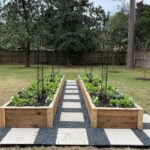Hillside vegetable gardening presents a unique set of challenges and opportunities for avid gardeners looking to make the most out of their space. In this article, we delve into the world of hillside vegetable gardening ideas, exploring innovative techniques, and best practices to help you create a thriving garden on a slope. Whether you’re a seasoned gardener or just starting out, there’s something for everyone in this comprehensive guide.
Gardening on a hillside requires careful planning and consideration due to the slope’s impact on factors like water drainage, soil erosion, and sun exposure. Understanding these unique conditions is essential for successful vegetable growth in such environments. By assessing your hillside and taking the necessary steps to address these challenges, you can create a productive and sustainable garden that will yield bountiful crops all season long.
When it comes to hillside vegetable gardening, selecting the right plants is crucial for ensuring success. Choosing vegetables that are well-suited to sloped terrain can make a significant difference in your garden’s overall health and productivity.
From root vegetables like carrots and potatoes to leafy greens and vine plants, we provide recommendations on the best vegetables to grow on a hillside. Stay tuned as we explore terracing techniques, soil preparation tips, watering strategies, pest management, seasonal planting guides, and creative design ideas to help you maximize your hillside vegetable garden’s potential.
Assessing Your Hillside
Before diving into hillside vegetable gardening, it is essential to assess the unique conditions and factors of your particular hillside. One of the primary challenges of gardening on a slope is proper water drainage.
Observing how water flows down the hill during rainstorms or irrigation can help identify areas that may be prone to erosion or excessive moisture retention. Additionally, consider the direction and intensity of sunlight throughout the day to determine which parts of the slope receive adequate light for plant growth.
Another crucial aspect to evaluate is the soil composition of your hillside. Slopes can vary in terms of soil quality and texture, so conducting a simple soil test can provide valuable insights into its pH levels, nutrient content, and drainage capacity. Understanding these factors can help you make informed decisions on amending the soil for optimal vegetable growth.
Furthermore, take note of any existing vegetation or structures on the hillside that could impact your gardening efforts. Trees or shrubs may cast shadows on certain areas, affecting plant growth, while fences or walls can create microclimates that influence temperature and wind patterns. By carefully assessing these elements, you can strategically plan your hillside vegetable garden layout to maximize productivity and create a harmonious growing environment.
Choosing the Right Vegetables
When it comes to hillside vegetable gardening ideas, selecting the right plants is crucial for a successful and thriving garden. Certain vegetables are better suited for the unique conditions found in hillside gardens, such as soil erosion, uneven terrain, and water drainage issues.
Some top recommendations for plants that thrive in hillside gardens include root vegetables like carrots, beets, and radishes which can anchor themselves well in the soil. Additionally, leafy greens such as kale, spinach, and lettuce are excellent choices for their ability to grow in different light conditions.
Another great option for hillside vegetable gardening is planting herbs like thyme, rosemary, and sage which require minimal maintenance and can add flavor to your dishes. These herbs typically have shallow roots that can adapt well to the sloped terrain of a hillside garden.
Furthermore, climbing vegetables such as peas, beans, and cucumbers are ideal for maximizing space utilization in a vertical garden setup on a slope. Their vines can easily latch onto trellises or supports, making them perfect additions to your hillside garden.
Incorporating a variety of plants with different growth habits and root structures will not only enhance the visual appeal of your hillside vegetable garden but also create a balanced ecosystem that promotes overall plant health. Experimenting with these recommended vegetables will not only make your gardening experience more enjoyable but also lead to a bountiful harvest throughout the growing season.
| Vegetable Types | Examples |
|---|---|
| Root Vegetables | Carrots, Beets, Radishes |
| Leafy Greens | Kale, Spinach, Lettuce |
| Herbs | Thyme, Rosemary, Sage |
| Climbing Vegetables | Peas, Beans, Cucumbers |
Terracing Techniques
Terracing is a crucial aspect of hillside vegetable gardening, as it helps to create level platforms on slopes, allowing for better water retention and minimizing erosion. One effective technique for building terraces is using retaining walls made of materials such as stone, wood, or concrete blocks.
These walls not only define the terrace levels but also help to keep the soil in place and prevent it from washing away during heavy rains. Additionally, incorporating steps or paths between terraces can make it easier to access different areas of your garden for planting, maintenance, and harvesting.
Maintaining terraces in hillside vegetable gardens is essential for optimal vegetable growth. Regularly inspecting the integrity of retaining walls and making any necessary repairs is important to prevent soil erosion and structural damage.
It’s also beneficial to practice good drainage techniques within each terrace to ensure excess water can flow out easily without causing waterlogged soil or potential flooding issues. Mulching around plants in terraced beds can further help with moisture retention and weed suppression while adding organic matter back into the soil over time.
When considering terracing ideas for your hillside vegetable garden, think about creating multi-level terraces that not only serve a functional purpose but also add visual interest to your space. Different heights and shapes can provide opportunities for planting various vegetables that have specific sunlight or spacing requirements. Additionally, incorporating creative design elements like hanging baskets, trellises, or decorative edging can enhance the overall aesthetics of your garden while maximizing productivity in limited space.
| Terracing Techniques Tips | Hillside Vegetable Gardening Ideas |
|---|---|
| Use retaining walls to define terrace levels | Consider incorporating vertical gardening elements like trellises |
| Maintain good drainage within each terrace | Plant cascading vegetables on higher levels for a beautiful waterfall effect |
| Add mulch around plants for moisture retention | Create terrace edges with colorful flowers to attract pollinators |
Soil Preparation
One of the key factors in successful hillside vegetable gardening is ensuring that the soil on your slope is prepared adequately to support healthy plant growth and high yields. Sloped terrain can present unique challenges when it comes to soil quality, including erosion, poor drainage, and nutrient depletion. However, with the right soil preparation techniques, you can create a thriving garden on your hillside.
Understanding Your Soil
Before planting your vegetables, it’s essential to assess the type of soil you have on your hillside. Conduct a simple soil test to determine its pH level, texture, and nutrient content. This will help you identify any deficiencies that need to be addressed before planting. Adding organic matter such as compost or well-rotted manure can improve the structure and fertility of the soil, providing essential nutrients for your plants.
Implementing Soil Improvement Techniques
To improve soil quality on a slope, consider using terracing techniques in addition to adding organic matter. Terracing not only helps prevent erosion but also creates level spaces for planting beds where soil amendments can be applied more effectively.
Incorporating cover crops like clover or vetch during fallow periods can also help build up the soil’s health by fixing nitrogen and suppressing weeds. Additionally, regular mulching can help retain moisture and prevent erosion while adding organic matter over time as it breaks down.
Managing Erosion
Erosion control is crucial when preparing the soil on a slope for vegetable gardening. Planting ground cover plants like creeping thyme or low-growing grasses can help stabilize the soil and prevent runoff during heavy rainfall.
Installing retaining walls made from materials such as stone or timber can also aid in erosion control while creating defined planting areas for your vegetables. By implementing these strategies for improving soil quality on your hillside garden, you’ll be setting yourself up for better yields and healthier plants throughout the growing season.
Watering Strategies
Understanding the Challenges
Hillside vegetable gardening presents unique challenges when it comes to managing water runoff and irrigation. The slope of the terrain can cause water to quickly flow downhill, leading to uneven watering and soil erosion.
Additionally, the angle of the hillside can make it difficult for water to penetrate deeply into the soil, resulting in inadequate moisture for plant roots. It is crucial to develop effective watering strategies to ensure that your vegetables receive the proper amount of water for healthy growth.
Terracing for Water Conservation
One effective technique for managing water runoff and irrigation in hillside vegetable gardens is through terracing. By building terraces or steps along the slope, you can create flat surfaces where water can be evenly distributed and absorbed by the soil. This helps prevent erosion and allows water to penetrate deeply into the root zone of your plants. Terraces also help reduce water wastage by preventing excess runoff down the slope, ensuring that your vegetables receive adequate hydration.
Drip Irrigation Systems
Another useful strategy for watering hillside vegetable gardens is implementing drip irrigation systems. Drip irrigation delivers water directly to the base of each plant through a network of tubes or pipes with emitters.
This method not only conserves water by minimizing evaporation and runoff but also ensures that each plant receives a consistent and precise amount of moisture. Drip irrigation systems are particularly beneficial on slopes as they allow you to control the flow of water more effectively, promoting healthier plant growth while reducing water waste.
Pest and Disease Management
Hillside vegetable gardening can be a rewarding and challenging endeavor. One crucial aspect of maintaining a successful hillside garden is effectively managing pests and diseases that can threaten your plants. By implementing preventive strategies and addressing issues promptly, you can ensure a thriving vegetable garden on your slope.
To prevent pest infestations in your hillside garden, consider planting companion plants that deter common pests or attract beneficial insects. Additionally, practicing crop rotation can help disrupt the life cycles of pests and reduce the likelihood of an infestation. Utilizing physical barriers such as row covers or netting can also protect your vegetables from insects like aphids or caterpillars.
When it comes to disease management in hillside gardens, proper sanitation practices are essential. Remove any diseased plant material promptly to prevent the spread of pathogens. Choosing disease-resistant varieties of vegetables can also help minimize the risk of infections. Implementing good air circulation by spacing plants appropriately and pruning when necessary can prevent damp conditions that encourage fungal diseases like powdery mildew or blight.
Incorporating natural solutions like neem oil or homemade organic sprays can effectively control pests and diseases in your hillside vegetable garden without relying on harmful chemicals. Regularly inspecting your plants for signs of trouble and taking swift action when needed will help maintain a healthy garden throughout the growing season. By being proactive in pest and disease management, you can enjoy a bountiful harvest from your hillside vegetable garden.
- Plant companion plants to deter pests
- Practice crop rotation to disrupt pest life cycles
- Use physical barriers like row covers for protection
- Remove diseased plant material promptly
- Choose disease-resistant varieties of vegetables
- Maintain good air circulation through proper spacing and pruning
- Utilize natural solutions like neem oil for pest control
- Regularly inspect plants for signs of pests or diseases
Seasonal Planting Guide
When it comes to hillside vegetable gardening, planning your planting throughout the year is crucial for a continuous harvest. Properly spacing out your crops and understanding the seasonal needs of each plant can help you maximize your garden’s productivity. Here are some tips and ideas to guide you through each season:
- Spring Planting: In the spring, focus on cool-season crops such as lettuce, spinach, peas, and radishes. These vegetables thrive in the mild temperatures of spring and can be harvested before the heat of summer.
- Summer Planting: As the temperatures rise, transition to warm-season crops like tomatoes, peppers, cucumbers, and squash. These vegetables need plenty of sun and warm soil to grow successfully.
- Fall Planting: For a fall harvest, consider planting crops such as broccoli, cabbage, carrots, and kale. These vegetables can withstand cooler temperatures and will continue growing even as the days get shorter.
Properly timing your plantings in accordance with each season ensures that you have a variety of fresh produce available throughout the year. Remember to consider your specific location and climate when planning your seasonal plantings for optimal success in your hillside vegetable garden.
- Rotate crops each season to prevent soil depletion and reduce pest infestations.
- Utilize cold frames or row covers to extend the growing season for certain vegetables.
- Consider companion planting to maximize space and improve crop yield by pairing mutually beneficial plants together.
By following a well-thought-out seasonal planting guide tailored to your hillside garden’s unique conditions, you can enjoy a bountiful harvest all year round while making the most of your gardening efforts. Experiment with different plant combinations and varieties to discover what works best for your specific hillside vegetable garden setup.
Creative Design Ideas
Hillside vegetable gardening presents a unique set of challenges and opportunities for gardeners looking to maximize their space and create a beautiful, productive landscape. By implementing creative design ideas, you can not only make the most of your hillside garden but also enhance its overall aesthetics. Whether you’re dealing with a steep slope or gently rolling terrain, incorporating thoughtful design elements can transform your hillside vegetable garden into a visually stunning and bountiful oasis.
One effective strategy for maximizing space in a hillside vegetable garden is to utilize vertical gardening techniques. Vertical structures such as trellises, arbors, and hanging planters can help you make use of limited ground space while also adding visual interest to your garden.
Consider growing vining vegetables like tomatoes, cucumbers, and beans that can be trained to grow upwards, freeing up valuable real estate for other plants. Additionally, vertical gardening allows for better air circulation and sunlight exposure, which can lead to healthier crops and higher yields.
In addition to vertical gardening, incorporating tiered planting beds or terraced slopes can help optimize your hillside vegetable garden’s layout and productivity. Terracing not only prevents soil erosion and water runoff on steep slopes but also creates distinct growing areas for different crops based on their sunlight and drainage requirements.
By carefully planning the arrangement of your terraces and considering the needs of each plant species, you can create a harmonious and efficient garden space that maximizes both yield potential and visual appeal. Embracing these creative design ideas will not only enhance the functionality of your hillside vegetable garden but also showcase its beauty as an integral part of your outdoor living space.
Frequently Asked Questions
What Vegetables Grow Best on a Hill?
Some vegetables that grow best on a hill are those with deep root systems, such as potatoes, carrots, and sweet potatoes. These plants can anchor themselves securely in the soil and avoid erosion.
Can You Grow a Vegetable Garden on a Slope?
Yes, it is possible to grow a vegetable garden on a slope with proper planning and care. To prevent soil erosion, terracing can be implemented to create flat surfaces for planting. It is important to ensure adequate drainage to avoid waterlogging.
What Crops Grow on a Slope?
Various crops can grow on a slope depending on the specific conditions and climate of the area. For example, crops like grapes, apples, berries, and certain types of grains can thrive on a slope if they receive enough sunlight and moisture. Additionally, legumes like beans or peas can help stabilize the soil on a sloped terrain.

Welcome to my gardening blog! I am passionate about plants and enjoy sharing my knowledge and experiences with others. In this blog, I will write about everything related to gardening, from tips on how to get started to updates on my own garden projects.





